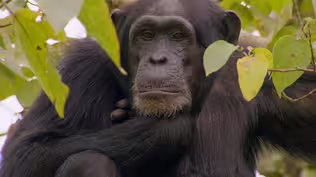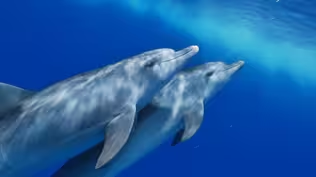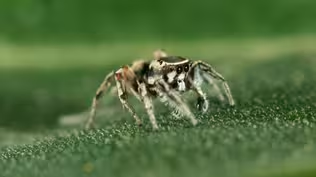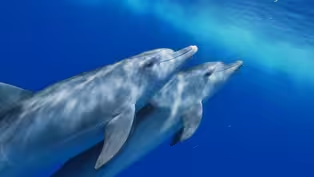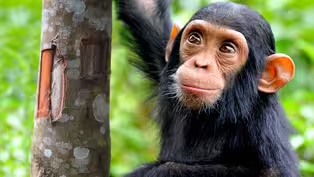
NOVA Wonders What Are Animals Saying?
Season 45 Episode 101 | 52m 57sVideo has Closed Captions
Can we crack the code of animal communication?
From singing whales and squeaking bats to thumping spiders and clicking dolphins, the world is filled with the exotic sounds of our fellow creatures. What are they saying? Can we decode their own communications? NOVA Wonders follows researchers around the globe who are deciphering an amazing array of clues that reveal how animals share information critical to their survival.
Problems playing video? | Closed Captioning Feedback
Problems playing video? | Closed Captioning Feedback
National corporate funding for NOVA Wonders is provided by Draper. Major funding for NOVA Wonders is provided by National Science Foundation, the Gordon and Betty Moore Foundation, the Alfred P....

NOVA Wonders What Are Animals Saying?
Season 45 Episode 101 | 52m 57sVideo has Closed Captions
From singing whales and squeaking bats to thumping spiders and clicking dolphins, the world is filled with the exotic sounds of our fellow creatures. What are they saying? Can we decode their own communications? NOVA Wonders follows researchers around the globe who are deciphering an amazing array of clues that reveal how animals share information critical to their survival.
Problems playing video? | Closed Captioning Feedback
How to Watch NOVA
NOVA is available to stream on pbs.org and the free PBS App, available on iPhone, Apple TV, Android TV, Android smartphones, Amazon Fire TV, Amazon Fire Tablet, Roku, Samsung Smart TV, and Vizio.
Buy Now

NOVA Labs
NOVA Labs is a free digital platform that engages teens and lifelong learners in games and interactives that foster authentic scientific exploration. Participants take part in real-world investigations by visualizing, analyzing, and playing with the same data that scientists use.Providing Support for PBS.org
Learn Moreabout PBS online sponsorshipTALITHIA WILLIAMS: What do you wonder about?
MAN: The unknown.
What our place in the universe is.
Artificial intelligence.
Hello.
Look at this, what's this?
Animals.
An egg.
Your brain.
Life on a faraway planet.
WILLIAMS: "NOVA Wonders" investigating the biggest mysteries.
We have no idea what's going on there.
These planets in the middle we think are in the habitable zone.
WILLIAMS: And making incredible discoveries.
WOMAN: Trying to understand their behavior, their life, everything that goes on here.
MAN: Building an artificial intelligence is going to be the crowning achievement of humanity.
WILLIAMS: We're three scientists exploring the frontiers of human knowledge.
FENTON: I'm a neuroscientist and I study the biology of memory.
RANA EL KALIOUBY: I'm a computer scientist and I build technology that can read human emotions.
WILLIAMS: And I'm a mathematician, using big data to understand our modern world.
And we're tacking the biggest questions...
Dark energy?
ALL: Dark energy?
WILLIAMS: Of life... MAN: There's all of these microbes, and we just don't know what they are.
WILLIAMS: And the cosmos.
♪ ♪ On this episode... (loud hum, owl hoots) animals made all kinds of noise.
(squeaking, chirping, bellowing) But what does it mean?
DAMIAN ELIAS: What they're telling the female is, "I'm free of parasites."
(roaring) WILLIAMS: Can we crack these mysterious codes?
CAT HOBAITER: The gesture means "Travel with me."
JARED TAGLIALATELA: His vocabulary was like a two-and-a-half year old human child.
KLAUS ZUBERBUHLER: This is Dr. Doolittle's dream.
WILLIAMS: "NOVA Wonders" "What Are Animals Saying"-- right now.
♪ ♪ (animal howls, croaks, low hum, guttural cries) All around us are alien tongues... (squeaking noises) and they don't come from space.
(bird screeching, lion groaning) FENTON: From whale songs, and wolf howls, to birds chirping and dolphins clicking...
The animal world is filled with mysterious conversations.
(chimps scream, wolves howl) Could we ever tap in?
We like to think that language sets us apart from the beasts.
But are we really all that special?
Today scientists are starting to decode those communications, discovering that we might not be alone.
I'm Andre Fenton.
I'm Rana El Kaliouby.
I'm Talithia Williams, and in this episode, "NOVA Wonders"-- "What are Animals Saying?"
And what does it say about us?
♪ ♪ ROBIN QUEEN: Come on.
When I'm working with Zach...
Lie down.
...it seems like magic.
Zach, that'll do.
Zach, here.
Experiencing that kind of connection with a dog-- Come by.
Lie down.
You're in sync, it's like any other connection you have with someone.
Lie down.
Where you really get along, and you're like, "Oh wow, that was an amazing conversation."
(whistles) WILLIAMS: Robin Queen is a linguist and competitive sheep herder from the University of Michigan, and like many of us, she likes to think she can talk with her dog.
Okay.
QUEEN: I think we are, as humans, we're fascinated by the idea, the Dr. Dolittle idea.
We want that to be true in some way (sheep bleating) When I started working with the dogs, I was shocked at what they could do.
Don't lose it.
Lie down.
WILLIAMS: And for border collies like Zack, herding sheep is just the beginning.
MAN: Get spider.
WILLIAMS: They appear to have a sophisticated understanding of language.
MAN: Get spider, bring it over here.
TECUMSEH FITCH: Their ability to learn human words are almost unlimited.
It seems to be, you know, every year a new dog comes by with a larger vocabulary.
WILLIAMS: A glance at YouTube proves the point.
FITCH: Tessa, get pumpkin.
WILLIAMS: Tessa can recognize four different toys.
FITCH: Good girl, bring it over here.
Excellent!
Get pig.
WILLIAMS: And that's puppies' play compared to Gable-- he knows 150.
Good boy.
Chase, find meow, find meow.
WILLIAMS: But all of these pooches pale in comparison to Chaser...
There's meow!
Come here!
I say throw me that ball.
WILLIAMS: ...who has been proclaimed the world's smartest dog.
QUEEN: Chaser was taught the individual names of over a thousand objects, and that's really pretty cool because it starts to try and get at that question of how special are humans?
FITCH: Chaser can understand hundreds of words, but all she can do is say "ruff."
She can't actually say any of those words back.
Now, what would be really impressive is when Chaser starts saying, "You go get the bunny."
Then I'd be impressed.
Find roach, find roach.
WILLIAMS: But as impressive as Chaser's feats are, do they qualify as... ALL: Language.
(echoing): Language.
Since the dawn of history, we've imagined animals to be like us.
I'm a horse, not a guinea pig.
Our stories are filled with talking creatures.
But what's the reality?
Well, to answer that question, let's talk about language.
To scientists, it's a learned set of symbols that can be combined into infinite meanings.
Just consider these-- Dog bites man.
Man bites dog.
By just changing the order of a couple words, the meaning of the message is completely different.
Well, this is the cornerstone of human language.
It allows us to tell stories, write poetry, negotiate contracts, whisper sweet nothings.
The question is, is this skill unique to us?
NEWSREEL NARRATOR: There are two chimpanzees in Rome who have brought a new "twist" in communication between animal and human... WILLIAMS: For over half a century, scientists have been working with our closest relatives to answer that question.
NEWSREEL NARRATOR: Viki was adopted when her own mother couldn't feed her anymore.
WILLIAMS: At first, scientists tried teaching language to chimps by raising them like children.
Perhaps one of the most famous of these was Viki.
NEWSREEL NARRATOR: She loves all the attention and affection, and she loves everyone.
Do this, Viki.
(grunts) WILLIAMS: Not only is this approach now considered unethical, it didn't work.
After seven years of intense training, she could barely utter four words.
MAN: "Mama," Viki.
(grunts) WILLIAMS: So, scientists switched to sign language.
VIDEO NARRATOR: If you watch Koko closely, she's learning to put her fingertips to her mouth to sign "eat."
WILLIAMS: Apes like Koko the gorilla hinted that apes have some ability for language.
VIDEO NARRATOR: Koko proved an adept student.
Everyone was amazed at how well the little gorilla was catching on.
JARED TAGLIALATELA: Let's do just a little bit more work and then we'll get a whole bunch of surprises, okay?
WILLIAMS: But it wasn't until this guy came along that researchers discovered exactly how impressive that ability was.
In the world of ape cognition, Kanzi is, you know, Elvis Presley.
All right, Kanzi, come on, tell me what this is, what's this a picture of?
COMPUTER VOICE: Banana.
Very good!
WILLIAMS: Instead of sign language, Kanzi learned these.
They're called lexigrams, abstract symbols that represent words.
What's this?
Look at this, what's this?
An egg, very good.
That's an egg, good job!
WILLIAMS: And Kanzi has learned over 400 of them.
TAGLIALATELA: Good, keep going!
(fanfare plays on computer) Good job, Kanz!
Plastic bag.
(fanfare plays on computer) TAGLIALATELA: Good, Kanzi, good stuff!
WILLIAMS: Amazingly, he started teaching himself this skill as a baby over 30 years ago.
I want you to go put the onions in your hot food.
TAGLIALATELA: Kanzi might have been around 11 or 12 at the time.
His vocabulary, spoken English vocabulary, was assessed in comparison to a two-and-a-half-year-old human child.
Now, I want you to take this spoon and put it on top of the bucket.
Can you do that for me?
Can you put it on top of that bucket?
WILLIAMS: Watching him today at 37, it would appear his language ability goes well beyond vocabulary.
Can you put it on top of the bucket?
Very good, that's a good job.
So I can ask Kanzi, "Hey, Kanzi, can you put the blanket on your head?"
And then I can ask Kanzi, "Can you sit on the blanket?"
Can you put it on your head?
(shrieking) (shrieking) Nice job, Kanzi.
Very good, very, very good.
Can you-- can you put the blanket on the cube?
(shrieks) Yeah, now can you sit on top of the blanket?
No, sit with your bottom on top.
Good job, Kanz, that's it!
Very good!
What he's obviously doing in that context is understanding not only the individual words, but the order in which they're arranged.
I think that's a big deal because that is one of the foundational elements for human spoken language.
CAT HOBAITER: Kanzi's a huge deal.
The studies with Kanzi and with the other apes like him allowed us to get a window into what great apes might be capable of in terms of learning our world and our communication.
TAGLIALATELA: Science has gained a whole lot from apes like Kanzi.
But, in all likelihood, Kanzi will sort of be the last of his kind.
Moving forward, I think our approach is shifted to one where we're starting to focus more on what the animals are doing with one another.
Cat gorilla have visit, Koko love.
WILLIAMS: Today, the questions scientists are asking is not whether animals can learn our language... Could you take my shoe off, please?
WILLIAMS: ...But if we can learn theirs.
PETER TYACK: It's very interesting that humans, who are very caught up in our own intelligence, when they wanted to understand whether other animals had a language like ours, the best thing we can think of was, can we teach that other species to speak our language?
FITCH: What you need to do if you want to understand animal communication is leave our own language behind.
Try as much as you can to become more like an animal and just not think in words and see what they're seeing and understand what they're feeling, what they're, what they're communicating about.
WILLIAMS: And when you do that, you discover a whole new world hiding in plain sight.
HOBAITER: When I first came to the rainforest, this was an alien world for me.
I had no clue what to do, how to be, how to move around in here.
(monkey sounds in distance) WILLIAMS: Budongo Forest, western Uganda.
Cat Hobaiter is setting off for work.
HOBAITER: Trying to understand their communication means understanding their behavior, their life, everything that goes on here.
I'm the luckiest person in the world because I get paid to run around rainforests with wild chimps.
I love this.
WILLIAMS: She's spent over ten years studying these chimps.
(chimps screeching) HOBAITER: It's been a pretty incredible thing to be able to watch some of these chimps from the day they were born until adulthood.
And I get to see the little detail, the soap opera of their life.
I'm an outside observer, but I've been here for so long I feel a part of the family, sometimes.
WILLIAMS: In the process, she has unearthed a hidden form of communication.
(scratching) Those scratches, shaking of trees?
To Cat, they aren't random motions.
They're part of an elaborate code, a secret language of chimps.
HOBAITER: All of these gestures are a part of chimpanzee communication and they grow up with them.
To humans, it might seem really subtle, like a tiny little push, or a tiny little pull, and that's really hard for us to see, but I think to the chimps it's very obvious what's going on.
So she's sitting down, looking up at her daughters, and she's giving a big scratch, so she's ready to go.
WILLIAMS: That's Harriet, and that scratch, it's not because she has fleas.
It's actually a signal to her daughter Harmony.
HOBAITER: And the little one's coming down now.
Well, that scratch has two meanings-- one of them is "groom me," and the other one is "let's travel together."
(chuckles) The loud scratch got her to come down.
They're all going to go down the tree, and that's them leaving together.
♪ ♪ WILLIAMS: To the untrained eye, the gestures don't look like much.
Only after hundreds of days and even more nights poring over 4,000 hours of video did Cat start to put the pieces together.
HOBAITER: So, in this case the gesture is a big loud scratch, but here it means "travel with me," "travel together," so... WILLIAMS: The reason she thinks Harriet's scratch means "let's travel" is because she has seen the same action and response dozens of times before.
So, you've got Klaus, the little young male chimp, and his mom, Kalima.
And he's ready to go, he wants to travel, so he gives this big scratch and then he comes around the back of his mum, climbs on, and they travel away together.
I sometimes look at this and I wonder if I'm seeing things, if it's really there, if I'm... you know, if it's all kind of in my imagination, and it's not until you're watching the videos over and over and realizing that you see this little movement, but afterwards, every time you see that little movement, the other chimp does something that you start to think, "Oh, there might be something in there."
WILLIAMS: Like this one.
If you look carefully, you can see the mother chimp raising her foot.
HOBAITER: In this case, the gesture is a foot present, and it means, "Climb on me."
This is a hard one to see.
You've got the mother, Jenny, walking down the transect, and her little boy, James, who she'd like to have climb on her back.
What she does is, she stops, she lifts her foot up, and she looks back over her shoulder at him, so you know that she's waiting for him.
She's waiting for him to give the response that she's looking for, and, in this case, he climbs on, and they travel away together.
WILLIAMS: But it's not enough to just see the same gestures over and over.
She needs to see some evidence of a back-and-forth, a conversation.
In this case, um-- he wants her to come and be groomed by him, so he's going to give these big scratches... (scratching) And he's waiting for a response, so, that didn't work, she didn't do what he wanted, she didn't do anything, so he here gives a little object shake, and he gives the scratch again, so he's combining those two gestures, but still nothing from her, she's just not interested at the moment, so he's giving a really exaggerated version.
It's like a back and forth between the two of them.
Big scratch, object shake, "Come on, I want to groom you, come over here."
That seems to have done the trick because she comes down and they start grooming.
The reason I know this is an intentional gesture, and not just a chimp shaking a branch in the forest, is because he gives it, and he waits for that response.
And when he doesn't get what he wants, he gives it again, he persists.
But once he does get what he wants, then he stops.
And it's the same as human conversations and communications.
After you've passed me the thing I'm asking for, then I don't keep on asking for it.
♪ ♪ WILLIAMS: Cat has come up with over 60 different gestures with more than 19 different meanings.
Stop.
Groom me.
And we're still picking up, possibly, you know, finding new ones all of the time.
Move closer.
I think in terms of an animal-to-human system of translation... Stop.
...we probably have the most meanings translated here.
Let's go.
Let's be friends.
And that's certainly compared to a lot of other animal systems of communication, it's much richer, it gives us much more detail than we've been able to find elsewhere.
Let's have sex.
(laughs) It's easy for us to want to focus in on language.
You know, we're quite self-obsessed as a species, we want to know what is it that might be special or different about ourselves.
But what the chimps have going on here is their own incredible, rich world of communication.
And it would be really easy just to focus in on their vocalizations.
But the-the real subtlety and texture and all of those rich meanings that we see in the gestures every day would be lost.
I think as humans, we're so language-centered that sometimes it's easy to forget that language is not the only way we communicate.
Language is just one of the channels of communication that we have as humans, and also not to think that language is the only model for animal communication.
In fact, we humans communicate with dozens of different expressions and gestures.
When you think about it, animals have all this and so much more.
Everywhere you look, you find elaborate systems of non-vocal communication.
From elephant body language... ...to honeybees telling their buddies how far and where to fly.
Even the simplest of creatures seem to have a lot to say.
WILLIAMS: Just consider these guys-- Habronattus formosos-- jumping spiders.
DAMIAN ELIAS: Spiders have some of the most unusual communication systems.
It really is kind of like this fascinating puzzle, and you use as much imagination as possible to sort of crack this language.
♪ ♪ WILLIAMS: Damian Elias from UC Berkeley spends his life listening to arachnids.
Stay there-- there you are, come on.
Working with spiders is not a normal occupation.
(buzzing) WILLIAMS: You might be surprised how much this tiny creature has to say-- especially when it comes to love.
ELIAS: Because these females only mate once in their lifetime, they need to make that choice count.
That decision better be as informed as possible.
♪ ♪ WILLIAMS: So you want to know what spiders are saying, you need to be a bit of a voyeur.
ELIAS: Oh my god, I've probably spent tens of thousands of hours watching spiders have sex and hearing spiders have sex and thinking about spiders having sex.
So he increases the thumps as he gets closer, Now he's really inching up close to her...
It's like you're trying to decode some type of alien language.
It's only with technology that we have now that we can even try to really decode what's going on.
So, what I'm going to do now is I'm going to make a female decoy.
I take a euthanized female, and then take a pin that has a small drop of beeswax and then I lower that pin onto the female.
And now using this decoy, we can have the male court it.
Here we have our courtship arena, which is essentially a needlepoint frame and female pantyhose with some pieces of reflective tape on them.
I'm going to place our female decoy into this little rig where it's hooked up to this kind of pulley system, and with it we can put her in a lifelike posture so she can fool a male, and so how we record these displays is using a laser vibrometer.
So, this is what you see right here.
WILLIAMS: The laser vibrometer converts vibration into sound.
Spiders don't have ears, and so they can't detect airborne sound.
Instead, spiders detect vibrations with their feet.
WILLIAMS: With the stage set, it's showtime.
Think of it as a five-act song and dance routine.
Act one... ELIAS: So, he's doing a sidling display there, they're really exposing a lot of the ornaments that they have on their face.
And those oftentimes are species-specific.
Females need to know that it isn't a predator that's trying to eat them.
And so you have this very safe display that starts very far away, and as soon as he gets close to the female, he will start to do the introductory display.
WILLIAMS: Now, the "singing" kicks in.
(thumping) ELIAS: There-- there, there is the introductory display.
Essentially, it's like, you know, "Listen to this, "now I'm going to start to tell you a bunch of information about myself."
And so, now he's going to go through a series of different signals.
(light scraping) WILLIAMS: First, the scrape.
ELIAS: Right there, that's a scrape.
(scraping) The parasite load is really tied to how loud the scrapes are.
WILLIAMS: By counting the parasites on over a hundred spiders, Damian found that the louder the scrape, the fewer the parasites.
So, what they're telling the female is that "I'm healthy, I'm free of parasites."
(scraping) WILLIAMS: Next, the thump.
(thump) ELIAS: The thumps are probably to kind of make sure to maintain the female's attention.
WILLIAMS: And once they've snagged that, time to put on the moves.
So, the third leg displays serve to draw attention to these ornaments that are on the third legs, and they kind of like, shake them around.
WILLIAMS: And, depending on how bright they are, Damian thinks that these tell the female about his past.
ELIAS: By being able to correlate the brightness of these ornaments and the quality of their food when they were younger, you can say they're talking about developmental history and their feeding history.
♪ ♪ WILLIAMS: And now for the finale.
(buzzing) ELIAS: And we have buzzes, these long tonal signals that inform the female about the male's size.
So, the louder it is, the deeper it is, the more the female wants them.
(buzzing) It gets more and more intense.
(buzzing continues) ♪ ♪ He might destroy the female.
Okay, yep... okay, all right, stop, get off.
Get off, get off.
WILLIAMS: Enough rehearsal.
Now for the real date.
Now we're going to use two live individuals.
So we can kind of track what the males are doing and how the females are responding to them.
WILLIAMS: To make sure he's right about these signals, Damian has to see how real live lady spiders respond.
You can see that the female now is just like really looking at the male, really looking at what he's trying to do.
WILLIAMS: For the guy, the stakes are high.
They aren't just singing for their supper, they're singing to make sure they don't become supper.
When females are assessing males, they're deciding on whether they're a potential mate or whether a potential meal.
(thump, buzzing) So right now, he's buzzing, so he's getting really close, so he's really going to... kind of like wrapping up, trying to get this female to mate with him.
Now he's really in the dangerous parts of the display.
So, it's getting faster and faster, now he's going to make a copulation attempt.
Oh, the female right there said, "No way."
♪ ♪ It's hard not to sort of feel sorry for that male.
And this is especially the case if the male is really trying his heart out, and he gets eaten.
Then I just feel absolutely terrible.
♪ ♪ FENTON: So, where do all these complex signals come from?
(thumping) It turns out what spiders are doing with all those thumps and buzzes is completely innate.
They're born knowing a fixed set of sounds.
What might we find if we looked further up the food chain?
For starters, it's clear what we humans do is very different.
We aren't born knowing language.
Our brains learn it by listening to others.
This skill is called vocal learning.
And only a few other animals have it-- whales and dolphins... (animals groaning, squealing) elephants and seals... (animals trumpeting, roaring) some birds, and bats.
Like us, these animals have a flexible communication system.
Scientists think that if we're ever gonna find a communication system like ours, it's going to be in one of these.
(bats squeaking) YOSSI YOVEL: If you enter a bat cave, you hear a cacophony.
Thousands of individuals simultaneously shouting at each other.
And you ask yourself, "Are they just shouting at each other, or is there more to it?"
(bats squeaking) WILLIAMS: Yossi Yovel is a bat biologist from Tel Aviv University.
YOVEL: Bats are probably one of the most vocal and most social mammals on earth.
Since the moment we're here, they haven't shut up for a second, right?
What exactly is the purpose?
Maybe we can say something about what exactly they are saying.
WILLIAMS: To understand how difficult a quest this is, watch what happens when Yossi's team records wild bats.
YOVEL: So this is a very sensitive ultrasonic microphone.
Here on the screen, you can see the vocalizations already in real time.
WILLIAMS: Trouble is, there's just too much noise.
YOVEL: Looking at this screen like this and trying to interpret what you see would be just like standing, you know, in the middle of a crowd of 500 people shouting at each other.
WILLIAMS: So back at the lab, Yossi's team has created a tightly controlled mini bat colony.
(bat flapping) Welcome to my bat cave.
(bats flapping) So, this is a male.
As you can see, bats are extremely cute.
They're... some people would describe them as small puppies or small flying dog.
(bats screech) So this is our controlled environment.
So if the cave we visited was like a stadium full of thousands of individuals, this is like your living room with a few friends, and I can put the camera there and monitor the full situation.
♪ ♪ So I'm going to put him on this wall and he will probably fly to the dark.
WILLIAMS: But placing bats in a controlled environment is just the first step.
To crack the code of bats-- or any animal for that matter-- requires making a connection between action and sound.
And that, as it turns out, is a real pain in the you-know-what.
(bats squeak) LEE HARTEN: Unfortunately, the only way to go about it is to go over a million hours of videos and just annotate.
WILLIAMS: First, the action.
What are the bats doing?
HARTEN: Generally, they're annoying.
They're really squabbling, kind of... No personal space.
(laughs) WILLIAMS: Because bats live in close quarters, they fight a lot.
So making a database of "what's the fuss about" is key.
This is a-a fight over food, basically.
So the first bat is holding a food item in its mouth, and the second bat is coming to try and steal it.
In this case, I would enter the context of this as fighting over food.
We see a female protesting a mating attempt by a male, and it's a failed mating attempt.
So, in this case, they're sleeping, one bat wakes up.
He shifts a bit, and he annoys the other bat by him.
WILLIAMS: It's a painstaking process, but one by one, Yossi's team creates a database of over 100,000 bat spats.
YOVEL: We did this for several months around the clock, not missing a single vocalization.
When you listen to these vocalizations, they all sound the same, but that's because you have a human brain and not a bat brain.
WILLIAMS: So they turn to the next best thing-- a brain of the silicon variety.
(bats squeaking) YOVEL: We fed this huge dataset into a machine learning classifier, and if there are differences, the computer algorithm will learn these differences.
WILLIAMS: That is, if there is in fact any connection between the sounds the bats are making and what they're talking about, the computer will find it.
And after months of work... (bat squeaking) YOVEL: We have essentially built a simple bat translator.
WILLIAMS: One that can translate four different bat calls, even ones it hasn't heard before.
(bat squeaks) This one is a fight over food.
(bat squeaking) This one a female saying something like, "Not tonight, big fella."
(small bat squeak) And this one: "Trying to sleep over here, knock it off."
(squeaking) YOVEL: You can now take a new vocalization, a vocalization that I've just now recorded, for example, in my colony.
You can feed it into this algorithm, and the classifier now will tell you what was the argument about without observing it.
KLAUS ZUBERBUHLER: It's fantastic, this is Dr. Dolittle's dream, you know, come true, when you've cracked the system and you can tell that these calls have these very distinct meanings.
WILLIAMS: And though they've only decoded a few bat calls, it's a start.
(waves churning) Is it possible other animals are communicating something bigger?
Much bigger?
(water splashing) ♪ ♪ (whale grunting) (whale crying) ELLEN GARLAND: I think everybody is used to hearing these beautiful, melodic, lovely songs from humpback whales, but it's not always nice to listen to.
When anyone asks me how pretty their songs are, I'm like, (chuckles sardonically).
(whale groaning) WILLIAMS: Ellen Garland is a humpback whale expert from the University of St. Andrews.
GARLAND: I have always loved being by the sea and on the sea.
Apparently, when I was six years old, I declared that I was going to be working with whales.
WILLIAMS: Whales, like bats, are vocal learners, and their songs are among the most complex forms of animal communication.
GARLAND: A single song typically is anywhere from five minutes to half an hour just for one song.
So, these guys sing for hours and hours on end.
WILLIAMS: Like human music, whale songs consist of repeated phrases and themes made up of individual units.
(whale singing) On average, there's about 34 to probably 36 different sound types that we recognize within the humpback song repertoire.
(whale trumpets) And we name them how they sound.
So, moans, groans, grunts, whoops... (whale trumpet) So, we'll call that a trumpet.
We have a lot of low frequency, very grunty sound... (whale grunts) And sort of ascending shrieks, so (imitates shrieking)... (whale vocalizing) (imitates whale vocalizing) (whale purrs) I feel like that one is definitely going to come back to haunt me.
WILLIAMS: Which begs the question: why?
Why are whales making such complex songs?
(water splashes) One clue might be that only the males do the singing.
GARLAND: Humpback song is really an acoustic peacock tail.
It's extremely showy and complex.
They're obviously communicating with each other.
You sort of want to understand why they're doing that, what they're trying to say.
WILLIAMS: To find out, Garland embarked on the world's first mapping mission of whale song.
GARLAND: I was to analyze song across the South Pacific region to try and understand what the songs were in multiple populations through multiple years.
WILLIAMS: Across the South Pacific, there are tens of thousands of whales living in separate groups.
Until Ellen came along, no one had ever compared their songs.
GARLAND: There were so many songs.
I couldn't keep them straight in my head, so I started to draw them.
And then from there, I could actually lay them down on the floor by population, by year.
WILLIAMS: Next, she color-coded the songs.
You can absolutely tell the difference between these song types because they have lots of different sounds in them and it's the particular arrangement of these sounds.
So, this is the blue song type.
(whale chirping) Now, if we listen to the dark red song... (whale trumpeting) As you can see, this is completely different.
WILLIAMS: Scientists thought that at any given moment, each group only sang its own tune.
FITCH: Well, we thought for a long time that all the males in an area sing the same song, but that it's different when you go to different areas.
It's different in, whatever, Hawaii from Tahiti.
GARLAND: So, we expected to find that all the songs within a year would be the same.
So I started analyzing and I started with the eastly population of French Polynesia, and there was some interesting irregularities in there, shall we say.
And I was like "Hm, this seems strange."
WILLIAMS: Strange because in French Polynesia in 2006, not all the males were singing the same song.
Sometimes the whales were singing the red song (low moaning sound) and sometimes the blue.
(high-pitched squealing) GARLAND: And then I went to the next population over, the Cook Islands.
And then I got to Tonga.
And then I got to New Caledonia, and, of course, finally, to East Australia, there was sort of a disconnect.
WILLIAMS: The same songs kept turning up, but in different places.
GARLAND: I talked with other researchers, and they were like, "Wow, I've seen that song type.
What is it doing over there in that year?"
♪ ♪ WILLIAMS: What was going on?
It wasn't until Ellen mapped everything out over time that a picture began to emerge.
Consider the blue song.
In 2002, it enters the charts in East Australia.
In 2003, it's all the rage in Tonga.
2004, it's a hit in Samoa.
And by 2005, it's number one in the Cook Islands.
Meanwhile, back in East Australia, those trendsetters had picked up a brand new tune.
GARLAND: All of the males threw the current blue song out the window, and started singing this dark red song type.
And then once they were singing it, it was then passed to the next population over, which is New Caledonia, and all those males learned this brand new song type, and again and again across the South Pacific, so to Tonga, American Samoa, the Cook Islands, and finally to French Polynesia.
It's almost a game of telephone across the South Pacific.
(whale song) FITCH: It was kind of like Beatlemania, you know, when the British invasion came over and transformed American music.
WILLIAMS: And this didn't just happen once.
As Ellen dug deeper, she found that this same thing happened year after year.
And that was the really big eureka moment.
BRENDA McGOWAN: The fact that we see repertoires of song shifting from one population to another across the Pacific in humpback whales shows that humpback whales have cultural transmission.
That's a big deal, because culture was once thought to be uniquely human.
♪ ♪ WILLIAMS: No one knows how these songs start, but why would male whales put so much effort into switching them?
We think that it's something to do with novelty.
A novel song makes you stand out against the background of singers around you.
You want to be able to stand out to that female and maybe you'll get more matings.
WILLIAMS: But are they just sexy tunes?
Could there be any lyrics?
GARLAND: So, exact content in them, what their message is, that's still unknown.
(whale trumpets) WILLIAMS: Could we ever know if any information is being exchanged?
♪ ♪ It's the same problem faced by scientists at SETI who listen to signals from space, hoping to find signs of intelligent life.
McGOWAN: SETI is really interested in knowing whether or not there are other beings in the universe that are intelligent.
And one of the ways to do that is to quantify and understand communication.
WILLIAMS: So why not start by trying to decode the "alien tongues" right here on earth?
LAURANCE DOYLE: Looking at the stars and saying, "Are we alone?"
I don't think is as useful as looking at the millions of other communication systems that are nonhuman on earth, and studying them so that if and when an extraterrestrial signal is received, we'll have a feel for nonhuman communication.
WILLIAMS: Easier said than done.
ARIK KERSHENBAUM: We're faced with a big problem, which is we don't have any idea what the meanings of the sounds are, so we can't translate them, we've got no Rosetta Stone, we can't say this sound means "fish" and that means "dog."
(animals howling) Think about it for a second.
Imagine you were an alien peering down on Earth, trying to decipher what these odd creatures had to say.
How would you know what to listen to?
(mix of different music blending together) This music stuff?
Laughter?
(laughter) Crying?
(crying) When you think about it, we humans are making lots of noise.
(man screaming) And only a fraction of it contains information we call language.
How would you be able to pick out the right parts?
Well, this is where the math comes in.
KERSHENBAUM: We're really looking for a statistical fingerprint for language.
Is there something about the way that the sounds have been put together into a sequence that is characteristic of language?
Consider ours for a moment.
In 1945, linguist George Zipf asked his students to plot out the frequency of each of the 264,430 words used in James Joyce's Ulysses.
He drew a straight line through it, and it had a 45-degree, minus-1 slope.
Oddly, the most frequent word occurred exactly twice as often as the second most frequent word, three times as often as the third most frequent word, and so on down the line.
In the logarithmic scale that mathematicians use, it looks like this.
So he thought, "That's interesting, what if I take another book?"
WILLIAMS: Darwin's Origin of Species.
DOYLE: Same thing.
What if I take a Chinese book?
Same thing.
Turns out, every human language on the planet follows this rule-- from Swahili to Arabic to Eskimo.
It's called Zipf's Law.
It suggested that the structure of language is fundamentally the same across different languages.
WILLIAMS: So what about animals?
Brenda McGowan at UC Davis and Laurance Doyle at SETI-- yes, the Search for Extraterrestrial Intelligence-- wanted to find out.
So they decided to analyze one of the most intelligent animals we know-- dolphins.
They communicate with an elaborate repertoire of whistles.
McGOWAN: By categorizing whistles into what we would call words, if you will, and I don't mean that literally, but the idea is to categorize signals into types.
DOYLE: Brenda McGowan had collected a bunch of signals and gotten their frequency of occurrence, and one morning, I got up, and decided, "Well, I wonder if this obeys Zipf's Law?"
WILLIAMS: And wouldn't you know... DOYLE: It obeyed Zipf's Law.
So I went and had a cup of tea, and then I went back and did it again, and it obeyed Zipf's Law.
McGOWAN: I was pretty excited.
Because, I mean, it could have been anything.
I mean, what's the probability that you're going to find something that's a negative-one slope in another species?
It's, you know, not only exciting, but it seems highly improbable.
DOYLE: It's one of those moments in science where you're going "Wait a second, "dolphins have a communication system with potential complexity as complex as humans."
It doesn't measure meaning, but it does measure what they could be saying.
McGOWAN: It doesn't necessarily mean that dolphins have language.
It just means that they may have a complex communication system that functions like language.
Which brings to the question-- do any animals have language?
KERSHENBAUM: People have set up language as being really the only remaining trait that separates us from all other animals.
The trouble is that language cannot be simply binary, it cannot be the case that we have language and no one else has even a part of a language.
That goes against everything we know about how evolution works.
So, there must be a spectrum of linguistic ability among animals.
♪ ♪ FENTON: And in fact, all the research today is telling us how much we share with animals.
Very good!
FENTON: But a huge mystery remains.
Where does language come from?
Unlike our other features, like opposable thumbs or walking upright, there are no fossils for speech.
The only way to answer this question is to dive deep into the biology, into our brains, our cells, and the very genes that make up you and me and every creature on earth.
Could it be that we're not as special as we think?
(loud crack) ♪ ♪ ERICH JARVIS: Many people have been assuming that we're much more different than animals when it comes to language.
(chimps screeching) ♪ ♪ When we start to realize the similarities, then we start to learn how we can get at this mystery of where language came from.
WILLIAMS: This is the question that drives Erich Jarvis at Rockefeller University.
A formally trained dancer from the Bronx, he's long been fascinated by language.
JARVIS: I felt like being trained as a dancer trained me to become a scientist, because both require a lot of discipline, hard work, creativity, lots of failure before you get success.
WILLIAMS: And in the past 29 years, Erich has had a lot of success, but the path to get there was not easy.
♪ ♪ JARVIS: I guess my story begins being born here in New York City.
We had what one might consider a broken family.
My father, he eventually became homeless, and he was later killed by a gang who were killing homeless people.
So I grew up with a single mother, we were not a wealthy family.
Culturally, we were wealthy.
I followed my mother's wisdom of trying to do something that has a positive impact on society, so I decided I'm going to become a scientist.
♪ ♪ I had to learn that it is more difficult for me, because I didn't have much to compare to.
There wasn't anybody in my family, anybody in my friend circle, anybody in my neighborhood that I knew was a scientist.
WILLIAMS: Nonetheless, Erich forged ahead, delving for answers about the origin of language in the brains of songbirds.
JARVIS: This mystery of where language came from, ten years ago, we had very little clue, But now, we're at the point where we're starting to understand how language brain pathways evolve, and the underlying genes that control that.
♪ ♪ WILLIAMS: Little did he know a huge clue would come from a single family.
JARVIS: When we first heard about the family, it was the first time that anybody had found any genetic change that causes something specific for speech.
WILLIAMS: Three generations of the Kearney family had difficulty speaking.
Analysis of the family's DNA led to a gene called FOXp2.
Humans with a mutation in the FOXp2 gene, who are otherwise normal, have trouble making complex sounds.
They can do "ka-ka-ka-ka," but they have trouble producing complex syllables, like "condition."
WILLIAMS: Songbirds also have a FOXp2 gene.
And when Erich inserted the same mutation into them, they too had trouble.
JARVIS: Then the birds can't imitate properly, just like in humans.
Even though we're separated by 300 million years from a common ancestor, a gene became used for a similar purpose in humans and vocal learning in birds.
WILLIAMS: Turns out, all animals have a FOXp2 gene, but it was assumed that it only affected communication in vocal learners.
But if this were true, why would all animals have the gene?
Erich wondered if its effect on communication could be more profound.
So, he decided to try the same experiment in a species that doesn't learn its vocalizations: mice.
They don't just squeak.
JARVIS: They sing.
When pitched down to the human hearing range, actually sound like songbird songs.
It's amazing.
(chirping) WILLIAMS: And like many songbirds, the males sing to impress the ladies.
JARVIS: Usually when you put female with the male, he produces these complex, very modulated syllables.
We call them the sexy songs.
WILLIAMS: But unlike songbirds, mice are born knowing their songs.
JARVIS: Our assumption was that mice are vocal non-learners, so putting this human mutation that causes a speech deficit shouldn't do anything to their vocal behavior.
♪ ♪ WILLIAMS: If the FOXp2 mutation does affect mice, that would mean the roots of human language spread well beyond a handful of vocal learners.
JARVIS: So above the cage here is a microphone that detects in the ultrasonic range.
WILLIAMS: To find out, you need to take twin mice like these-- identical in every way except the mutation.
First, the normal mouse.
JARVIS: I'm going to go ahead and put him in a cage now and see how he responds to this female, and I'm going to expect since he doesn't have the mutation, that he's going to produce more complex songs to her.
So, here we go.
♪ ♪ (chirping) There he goes.
That's a complex syllable type.
There he goes, see?
So like we have these pitch jumps here, from here to here, here to here, and then these long syllables like this followed by a short one.
This is what a normal animal should be singing.
♪ ♪ WILLIAMS: Now for his brother, the mouse carrying the same mutant version of the gene that affects speech in humans and songbirds.
JARVIS: Okay, so now I'm going to take his brother, who has the FOXp2 mutation, and I'm going to put him in the cage.
So our question is will his mutation affect his ability to produce song, and if so, how?
(chirping) Ah, here he goes, here he goes.
These are more simple syllables.
(stilted chirping) Simple.
Here you go... he's singing.
So this guy, he's behaving normally, but he doesn't seem to want to produce these more complex sequences as we've seen in his brother.
♪ ♪ This female, she's like, "Eh."
(mice squeaking) So, what you see here are sonograms of the sounds that these mice are producing, and what kind of almost looks obvious here, this is the complex song that the wild type mice sing to the female.
(chirping) You take the FOXp2 mice with the mutation, instead of doing this, they do this.
The simple song, where they have these simple syllables, not the same as what you're seeing in the wild type mice.
(stilted chirping) So I'm actually even struck more about the stark contrast that I'm seeing in these two brothers, one that doesn't have the mutation and one that does.
Everything else about them is the same.
♪ ♪ WILLIAMS: What it means, according to Erich, is that the roots of human language run deeper than we previously thought.
Even in a species that's born knowing its vocal repertoire, FOXp2 appears to affect the ability to make complex sounds.
JARVIS: And it suggests that it's not a black or white world of the haves and the have-nots, it's a continuum.
And it brings us closer to these other animals, in our abilities, in our cognition, in our speech.
I'm not saying we're the same, mice and humans aren't the same, we're more advanced, but we're closer than what people realize.
♪ ♪ (squealing) McGOWAN: Language is like the last barrier that we seem to hold as being truly unique, so we really sort of have to change our way of thinking about what I would call a continuum between other animals and humans.
(screaming) HOBAITER: If we only think about human language, we're only focusing on what might be shared between human language and communication in other species, we could be missing so much of what other species do.
(buzzing, thumps) PETER TYACK: I think we've discovered enough and had enough surprises to be absolutely sure that we've just scratched the surface.
And there is this amazingly complex and wonderful world to explore, which should keep generations of biologists and psychologists busy into the future.
(birds singing) ♪ ♪ "NOVA Wonders" is available on DVD.
To order, visit shop.PBS.org or call 1-800-PLAY-PBS.
"NOVA Wonders" is also available for download on iTunes.
♪ ♪ ♪ ♪
Clip: S45 Ep101 | 2m 36s | Animal and human forms of communication may be much closer than we previously thought. (2m 36s)
Video has Closed Captions
Clip: S45 Ep101 | 5m 17s | Meet Dr. André Fenton, the co-host of NOVA Wonders. (5m 17s)
Video has Closed Captions
Clip: S45 Ep101 | 4m 5s | Meet Dr. Rana el Kaliouby, the co-host of NOVA Wonders. (4m 5s)
Video has Closed Captions
Clip: S45 Ep101 | 4m 25s | Meet Dr. Talithia Williams, host of NOVA Wonders. (4m 25s)
Video has Closed Captions
Preview: S45 Ep101 | 1m 21s | A 6-part series exploring the biggest questions on the frontiers of science. (1m 21s)
Video has Closed Captions
Clip: S45 Ep101 | 5m 37s | Meet Erich Jarvis, a scientist studying vocal-learning in mice and songbirds. (5m 37s)
The Secrets of Spider Seduction
Video has Closed Captions
Clip: S45 Ep101 | 2m 56s | Can scientists stomach hours of spider sex in order to understand their language? (2m 56s)
What are Animals Saying? Preview
Video has Closed Captions
Preview: S45 Ep101 | 28s | Can we crack the code of animal communication? (28s)
Video has Closed Captions
Clip: S45 Ep101 | 4m 23s | Chimps have their own rich world of communication. (4m 23s)
Providing Support for PBS.org
Learn Moreabout PBS online sponsorship
- Science and Nature

Capturing the splendor of the natural world, from the African plains to the Antarctic ice.

- Science and Nature

Learn how centuries of knowledge helped our ancestors understand the mysteries of space.












Support for PBS provided by:
National corporate funding for NOVA Wonders is provided by Draper. Major funding for NOVA Wonders is provided by National Science Foundation, the Gordon and Betty Moore Foundation, the Alfred P....



